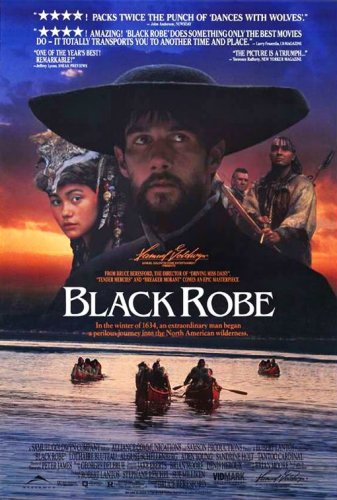| Date | Area | Gross |
|---|---|---|
| USA | USD 8,211,952 |


When Mestigoit the Sorcerer meets Laforgue, Laforgue is reading the Breviary (daily prayer of a priest).
The page is clearly at DOMINICA V POST PASCHA, the fifth Sunday of Easter which falls between 3rd May and 6th June.
Yet the action is supposed to be taking place in the autumn-winter of 1634.
In one of the flashbacks to France, Father Laforgue's mother says she is praying to St.
However, Joan of Arc was not canonized until 1920.
Laforgue is seen baptizing with saliva.
Saliva is not valid matter for baptism and no 17th century Jesuit, who knew their theology very well, would have baptized with saliva.
He could have melted the snow to obtain some water.
The French characters all speak English.
This would normally be overlooked as a conventional dramatic device, were it not for the fact that subtitles are used for the Native Americans.
The French girl plays a recorder solo from 'Der Fluyten Lust-hof" published in 1644, while the film is set in 1634.
Chomina, left behind to die, says to the priestan Algonquin word translated as "go", then "Black Robe", and the first word again.
The subtitles, added here as to any Algonquin dialogue, substitute "my friend" for "Black Robe".
This considerable shift in meaning, added in translation, is not compatible with the character.
Cinematographer of the Year |
AFI Award |
| Best Achievement in Cinematography |
| Best Achievement in Costume Design |
| Best Achievement in Editing |
| Best Achievement in Sound |
| Best Actor in a Lead Role |
| Best Actor in a Supporting Role |
| Best Director |
| Best Film |
| Best Original Music Score |
Golden Reel Award |
| Best Achievement in Art Direction |
| Best Achievement in Cinematography |
| Best Achievement in Costume Design |
| Best Achievement in Direction |
| Best Achievement in Film Editing |
| Best Motion Picture |
| Best Music Score |
| Best Performance by an Actor in a Supporting Role |
| Best Performance by an Actress in a Supporting Role |
| Date | Area | Gross |
|---|---|---|
| USA | USD 8,211,952 |
Black Robe may have been better if a similar movie hadn't crossed my mind as I watched it. That movie was Silence, Martin Scorsese's masterpiece with similar themes that was released 25 years later.
Champlain's personality was the only thing that saved the colony from extinction. Attached to the Rouen company as he was, Nicolet nevertheless deplored their lack of zeal for the advancement of the colony, but like Champlain he remained faithful to his ideals and when in 1627 Richelieu formed the company of the Hundred Associates he yielded to the new order.
This exquisitely photographed film portrays the cultural clash between Europeans (in this case the Europeans happen to be French) and various native tribes in seventeenth century North America without romanticizing either French culture or that of the native peoples.Perhaps the most striking feature of this film from my perspective was utter arrogance of the Europeans to come into a wild country presuming the superiority of their way of life over that of the indigenous peoples.
Preceding "Last of the Mohicans" but following "Dances with Wolves", Bruce Beresford's "Black Robe" seems to strike a neutral ground toward depicting Brian Moore's screenplay of a Jesuit on Mission bringing the Christian Faith to Huron Indians. Although I have not read the novel, the movie's cinematography, costuming, and settings are first rate to be sure.
Black Robe (1991) Released with poor timing in the aftermath of a similar themed film - Kevin Costner's Dances with Wolves - Black Robe largely got lost in the shuffle. That's a shame, because the film is actually quite remarkable.
Brian Moore grew up in Northern Ireland and considered joining the priesthood before he moved to Canada and abandoned his Catholic religion later in life. I've not read this nor any of his other novels, but I am told that on several occasions he explored the idea of a priest losing his faith, and I wonder if perhaps, in spite of his outward angst against the Irish clergy, he wasn't in fact (like so many ex-Christian writers) struggling to cast of his guilt and to justify abandoning his own vocation.
Black Robe is a credible attempt to dramatize the clash of cultures in the early seventeenth century in what is today the region comprising northern New York State and Quebec, Canada. In this movie the principal characters: a Native chief, his wife and daughter, a French priest (the "Black Robe") and his companion, a young French man, are people caught up in a chain of events that highlight the similarities and differences, as well as the best and the worst features, of two cultural groups, one French and Catholic, the other Native American and non-Christian, as they take the first tentative steps in establishing contact.
"Black Robe" is a beautifully filmed, sensitive and in the end emotionally moving film depicting the work of French Jesuit missionaries in New France in the 17th century and their interactions with the natives (particularly the Hurons) of the region. The real power of the movie comes from the authenticity with which both the Jesuits and the natives are portrayed.
For a film about Christian missionaries, this one verges on Horror. Not for the weak of heart--or stomach.